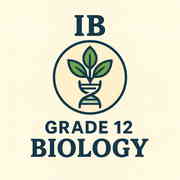Professional Courses
Industry-relevant training in Business, Technology, and Design
Categories
Interactive Games
Fun games to boost memory, math, typing, and English skills
Typing
Memory
Math
English Adventures
Knowledge

IB 12 Biology
The IB Grade 12 Biology HL course delves into the complexities of biological systems, exploring life from the molecular level to entire ecosystems. Students engage with unifying themes that connect various biological concepts, enhancing their understanding of the natural world. The curriculum encourages critical thinking, scientific inquiry, and the development of practical skills through laboratory work.
Course Chapters
Cell Theory
The chapter discusses the fundamental concepts of cell theory, defining the critical roles cells play as the basic unit of life, their structures, types, and functions. It further explores eukaryotic and prokaryotic cells, their ultrastructures, membrane dynamics, and processes of cell division, including mitosis. Additionally, the chapter emphasizes the significance of microscopy and cell fractionation techniques in understanding cellular biology.
Molecular Biology
This chapter covers the fundamental concepts of molecular biology, including the properties of water, the structure and function of macromolecules, enzyme activity, DNA structure and replication, transcription and translation, and cellular respiration and photosynthesis. Each topic addresses how these biological molecules and processes contribute to life and energy conversions essential for organisms.
Genetics
Genetics is the study of heredity and variation, focusing on the role of chromosomes, genes, and alleles. Key processes such as meiosis, genetic variation, and inheritance patterns contribute to the diversity of traits in organisms. DNA technology has emerged as a powerful tool with applications in medicine, agriculture, and forensic science, enabling manipulation and analysis of genetic material.
Ecology
Ecosystems consist of both biotic and abiotic components, where energy flows from producers to consumers and decomposers, forming intricate food chains and webs. Essential nutrient cycles, including the carbon, nitrogen, and water cycles, sustain life within ecosystems. Population dynamics are influenced by factors such as growth patterns, limiting factors, and species interactions, while human activities pose significant challenges to biodiversity, necessitating conservation strategies and global cooperation.
Evolution and Biodiversity
Evolution is the cumulative change in heritable characteristics of populations over time, supported by evidence from the fossil record, selective breeding, homologous structures, molecular evidence, and biogeography. Natural selection drives species evolution by promoting advantageous traits, resulting in adaptation and speciation. Classification based on evolutionary relationships aids in understanding biodiversity and the phylogeny of organisms.
Human Physiology
The chapter covers human physiology, detailing essential systems including digestion, blood circulation, immune response, gas exchange, hormonal balance, and the musculoskeletal framework. Each system is explained in terms of structure, function, and the vital processes involved. Key mechanisms underpinning homeostasis and disease management are also addressed.
Nucleic Acids and Protein Synthesis (HL)
Nucleic acids play a crucial role in the genetic architecture of life, with DNA and RNA serving distinct functions in encoding, transmitting, and reflecting genetic information. Understanding the nuances of nucleic acid structures, replication processes, gene expression mechanisms, and the impact of mutations are fundamental to the field of molecular biology.
Metabolism, Cell Respiration, and Photosynthesis
Metabolism involves the totality of chemical reactions within organisms, organized into metabolic pathways, where enzymes play a crucial role in reducing activation energy. Cell respiration transforms biochemical energy into ATP through glycolysis, the link reaction, the Krebs cycle, and the electron transport chain, while photosynthesis converts light energy into chemical energy in two stages: the light-dependent reactions and the Calvin cycle. Anaerobic respiration varies between organisms, with lactate produced in animals and ethanol in yeast.
Plant Biology
Transport in plants involves two key systems: xylem, which moves water and minerals from roots to leaves, and phloem, which distributes organic compounds from sources to sinks. Plant growth is regulated by hormones and occurs in meristems, with responses to light and gravity affecting growth direction. Plant reproduction includes the structure and function of flowers, the processes of pollination and fertilization, and influences like photoperiodism on flowering.
Genetics and Evolution
The chapter explores key concepts in population genetics, including gene pools and allele frequencies, the Hardy-Weinberg equilibrium, and mechanisms of speciation. It discusses the impact of genetic engineering and associated ethical considerations. Additionally, it delves into the principles governing the genetic diversity and evolutionary changes within populations.
Animal Physiology
The chapter covers essential biological processes including osmoregulation, the functioning of the human kidney, nervous system structure and communication, reproductive physiology, and thermoregulation in organisms. It explains how various systems work to maintain homeostasis and facilitate reproduction while highlighting key structures and processes involved.
Scientific Investigation Skills
The chapter emphasizes the importance of designing experiments by identifying variables, controls, and ensuring reliability and validity in research. It covers data collection and analysis techniques, the significance of various graph types for biological data representation, and the elements of writing lab reports and internal assessments. Each section integrates practical guidelines and examples to support effective experimental design and reporting.
Exam Techniques and Past
Mastering exam techniques involves understanding command terms, effectively structuring answers, and managing time during examinations. Familiarity with past questions by topic allows for targeted practice, which enhances problem-solving skills and exam performance. Implementing these strategies can significantly improve students' results.
